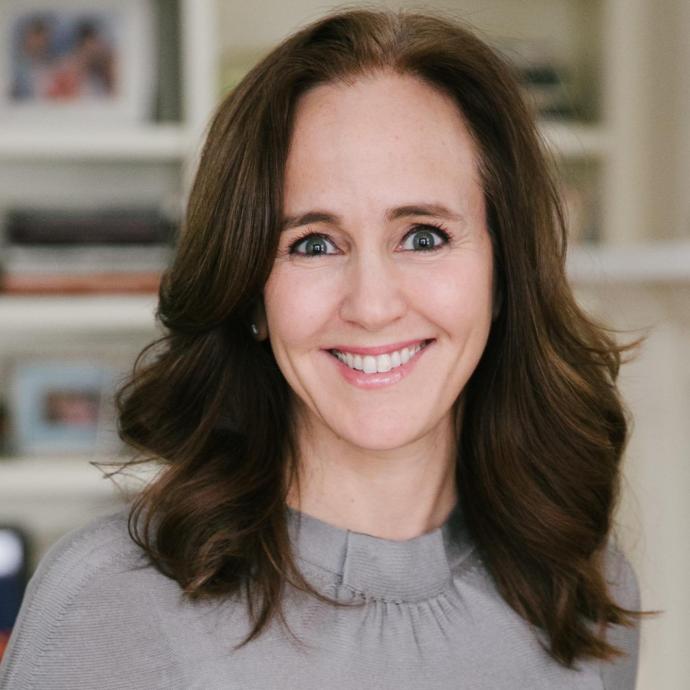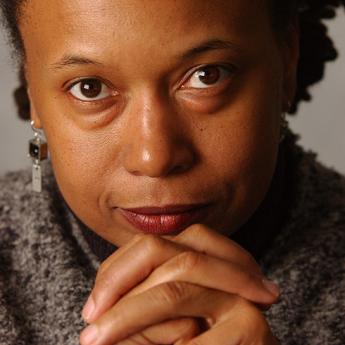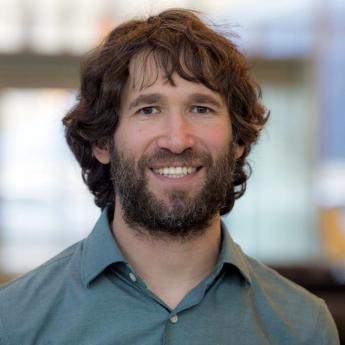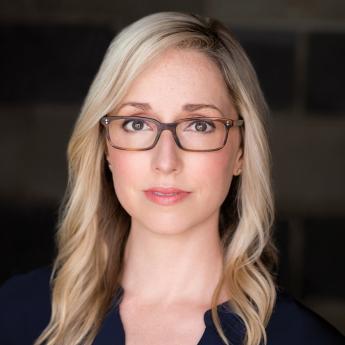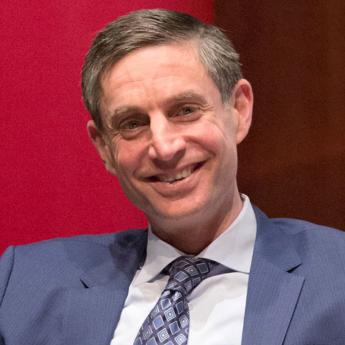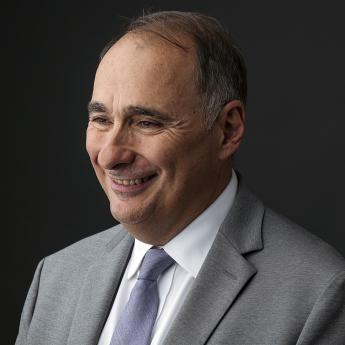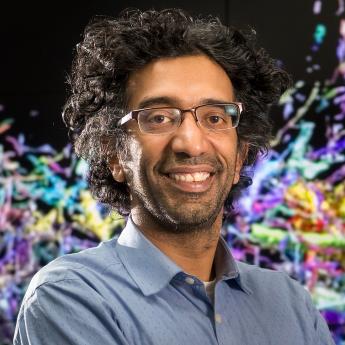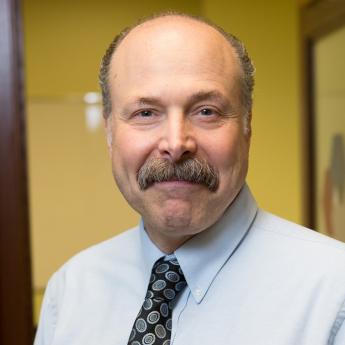Show Notes
When Prof. Dana Suskind first began implanting devices called cochlear implants on babies who couldn’t hear, she quickly noticed something about her patients.
“The cochlear implant would allow sound to go to a child’s brain, but something else was needed to make those sounds have meaning.”
Suskind observed that many of her patients struggled to develop language because their parents didn’t talk to them as much. It was a revelation that began inspired her to found the Thirty Million Words Initiative, which aims to improve educational differences. The program has since led to a best-selling book and most recently, a community partnership that will test these innovative ideas on a national scale.
On this episode of Big Brains, Suskind discusses her transformation from surgeon to social scientist, how auditing a UChicago class shaped her work and simple advice to teach kids from day one.
Subscribe to Big Brains on Apple Podcasts, Stitcher and Spotify, and rate and review the podcast.
Recommended:
- Thirty Million Words research reaches parents through book, programming
- The surgeon who became an activist for baby talk—National Public Radio
- Your Baby’s Brain Holds the Key to Solving Society’s Problems—National Geographic
- Does ‘Early Education’ Come Way Too Late?—Freakonomics Radio
- ‘Three T's’ uses words to feed toddlers' brains—USA Today
- Dana Suskind on the Importance of Talking (More) to Your Child—Chicago Magazine
Transcript
PAUL RAND: Every parent knows that talking to their kids is important, but University of Chicago professor Dana Suskind found something incredibly intriguing through her work as a leading cochlear implant surgeon-- how much parents talk to their kids and how much those kids hear has a profound impact on their intellectual development. Dana was so intrigued by the findings that she founded the 30 Million Words Initiative and published a bestselling book to help ensure that parents of all economic levels know how to boost their child's achievement. Enjoy our conversation, and think about Dana's advice the next time you talk with your kids.
RAND: Well, Dana, welcome to Big Brains.
DANA SUSKIND: Thank you so much for having me.
RAND: Absolutely. It's wonderful to have you here. Now, you are a pediatric surgeon by training, is that right?
SUSKIND: Yes, I am a pediatric cochlear implant surgeon.
RAND: Why don't we start with what a cochlear implant is, because I think that's key to this whole story.
SUSKIND: It is. So a cochlear implant is an amazing piece of technology that allows a child born deaf the ability to hear, to talk, and, most importantly, meld into this world, both educationally and socially.
RAND: And so you have been doing cochlear implants for how many years at this stage?
SUSKIND: I started the cochlear implant program here at the University of Chicago over at Comer probably about 11, 12 years ago.
RAND: And so you had been doing the cochlear implants for a number of years, but you noticed something. What was that?
SUSKIND: So I started the implant program very excited. Started implanting children from the south side of Chicago, across Chicago, across the country, and started noticing huge differences in outcomes of my patients, who all looked like they had the same potentials for learning how to talk and learn.
RAND: And what age were most of these kids, if there is an average age of kids coming in for the implants for you?
SUSKIND: So traditionally, you want to implant as early as possible. Less than a year is optimal. Back then, it was-- you know, it's a range between zero and two, two plus. So started implanting these cute little kiddos, and started noticing huge differences in outcomes after implantation. Some were learning how to talk on par with their hearing peers, while others would barely be able to communicate.
RAND: And that led you to start asking a bunch of questions. Is that right?
SUSKIND: Yes. So I always say I realized that the cochlear implant came with a very large asterisk. And what was that asterisk? It's that the cochlear implant would allow sound to go to a child's brain, or the quote unquote hearing. But something else was needed to make those sounds have meaning. And it was that sort of realization that really started me on this journey that, I always say, from surgeon to social scientist.
SUSKIND: I always say that, if I wasn't here at the University of Chicago-- and I know it sounds like I'm plugging the U of C-- I'm not sure if this would have ever happened. There, scientists from all different domains, from medicine to psychology to economics, really helped sort of fuel my understanding of what was going on. And one of the first things that I did-- and you're going to laugh-- is I actually audited a class in child development.
RAND: No kidding.
SUSKIND: Yes. And that aha moment was learning about this study by Hart and Risley which basically showed that some children, especially children born into poverty, heard 30 million fewer words than their more affluent peers.
RAND: By what age?
SUSKIND: By the end of the age of three. But what's really important, because people get sort of stuck on this 30 million words because it's so impressive-- and it was the aha moment for me--
RAND: This is an old study, right?
SUSKIND: It’s a very old study, and it's really just the first sentence of a really robust literature. It is just the beginning. And if that was the end, it would be the end. But it's since then built upon by many researchers going deeper and in more complex ways. Actually, here at the U of C, people like Janellen Huttenlocher and Susan Levine and Susan Goldin-Meadow and all of these amazing scientists have really shown the differences in early language environments, differences in early interaction are critical for children's not just vocabulary development, but educational trajectories. And what's very interesting, though, is that, while that was the beginning, it's really been the intersection of this with emerging neurosciences that have really brought clarity as to what we're seeing and why it is.
RAND: So from their earliest of ages, how much parents or other in their lives were interacting with them was making a difference even before they could talk.
SUSKIND: Exactly.
RAND: OK.
SUSKIND: And what's fascinating is that, as I learned, what I was seeing in my patient population and the fact that it had less to do with their hearing loss than the world in which they were born really took me to the next level of realizing that what I was seeing in my patient population was really just mirroring what was going on in larger population at large. And what we talk about in terms of the educational achievement gap or opportunity gap really take their roots in the earliest language environments of children in the first three years of life.
RAND: There's a couple of gaps. There's a word gap and an achievement gap. Word gap leads to an achievement gap, is that right?
SUSKIND: Yeah, so I always say I am really not a huge fan of the term word gap.
RAND: OK.
SUSKIND: Even though everybody associates me with it. What people talk about in terms of a word gap, it's really a metaphor, a metaphor for the power of early language environments in the first three years of life for building a child's brain. And what is the achievement or opportunity gap? That's the persistent educational differences that we see in this country, often along socioeconomic lines. So this quote unquote "word gap" really is one of the root causes of the educational achievement gap.
RAND: If you could define and say, well, here's the problem as pretty well articulated, what does that mean, and what do you do about that?
SUSKIND: For me, this allowed me to see families, and the inherent power in families, in a totally different way. All of the parents of my patients love their children, wanted their children to be successful and happy. What it allowed me to see is this untapped power in families, because just because you love your kid doesn't mean you know the brain science.
RAND: Of course.
SUSKIND: I don't know about you, but when I had my first child, I had no idea the importance of talking and interacting.
RAND: Right.
SUSKIND: And so this really allowed me to see, well, if I want to give each of my patients the same chances for succeeding after implantation, or if I want every child in this country to have the same opportunities for reaching their own potential, one of the keys was really empowering parents from all different backgrounds with both the knowledge, skills, and strategies best to optimize their children's brain development.
RAND: If the amount of time parents or others are talking to their kids up until age three of the brain's development is just an absolutely crucial period, and if that foundation is not put into place, it really could affect them for the rest of their lives.
SUSKIND: I always want to say, look, it's never too late, but it is the difference of remediation versus prevention, trying to fix an issue versus preventing it in the first place. And that is really what I think, in this country, I mean, hopefully we're heading towards, is really understanding that education and learning don't start on the first day of pre-K, they start on the first day of life. And that if we're going to move the needle, we need to truly partner with those whose science have clearly shown are the key brain builders of children, parents and caregivers, in starting this optimal foundational brain development from day one.
RAND: And the solution that you kind of get into, you've kind of summarized it in something called the three T's. Is that right?
SUSKIND: So the three T's are, at the individual level, what needs to happen between adult and child to optimally stimulate the child. And what are the three T's? Tune in, talk more, take turns.
RAND: OK, let's take each one of those.
SUSKIND: All right.
RAND: What's tune in?
SUSKIND: Tuning in is really tuning into your child, following your child's lead, using child-directed speech, which is that singsongy speech. Talk more--
RAND: And this is at the earliest ages of their--
SUSKIND: --this is from day one.
RAND: --day one.
SUSKIND: This is from day one. Actually, your baby can even hear you in utero. So talk more is just as it sounds. Using rich vocabulary, talking about the past, the future, and the present. And then take turns, take turns is really having a conversation with your baby from day one. It's not taking turns like sharing.
SUSKIND: And let me tell you, so these three T's are sort of the behavioral measuring stick that parents can use when they interact with their child. And whether they're changing their child's diaper or taking the Metra, it's an opportunity to enrich their environment. So the three T's are the foundation of all the programs that we develop. We basically develop programs to work with families and caregivers, taking what I like to call a public health approach to early learning.
SUSKIND: We meet parents on maternity wards on day one when their baby's born and getting the hearing test. We have programs that work through the pediatricians' offices in the first six months of life. We work with families at home in group settings. And we have these different interventions meeting families where they are.
RAND: So Dana, when you first got going on this, this number 30 million words really stood out. I think it's what captured your imagination from the beginning. Can you talk about the 30 million words? Your center, TMW, stands for Thirty Million Words, but there certainly is some question of is it four million or 30 million. Where does this millions of words thing play into this?
SUSKIND: It was that number in that study which really first sort of crystallized my understanding. As I said, if it ended there and it didn't go and all the robust science that followed hadn't occurred, we wouldn't be at this point. The initial Hart and Risley study recently has undergone the social science replication issues, and they say, well, maybe it's a four million word gap. Frankly, I don't care if it's 30 million, I don't care if it's four million. It's really the first sentence in what is, without a doubt, a robust literature connecting early language and interaction to children's foundational brain development. It's a metaphor, a metaphor for the power of parents and their talk and interaction to build a child's brain.
SUSKIND: So the TMW Center for Early Learning and Public Health is really an outcome of a decade of work. It's a center that's a joint venture between the biological science division and the social sciences. I started it with John List, the behavioral economist. And it's really based on the science that we've talked about, that if we want to really move the needle on educational disparities in this country, around the world, we need to be starting earlier, and using science to inform all that we do so that every child can have the opportunity of reaching their potentials.
RAND: So what are the goals for this? Is this your major outreach engine at this point, is this center?
SUSKIND: So the center is not just an outreach engine, it's an engine for science. Because we know the underlying science behind disparities doesn't mean that we know exactly how to approach them and allow all parents to enrich their children's language environments in the best possible ways. And so it is a center with the overall larger goal of really a population-level shift, where all parents and caregivers in this country understand the power of their language and the brain science so that they can optimize their children's early brain development.
RAND: At some point, there's likely to be a meaningful announcement coming up. And it sounds like it could end up having a pretty big impact on the work that you're doing. Can you talk about that a little bit?
SUSKIND: We are about to announce our formal partnership for our community-wide demonstration project. As I mentioned before, we have developed this public health model for early learning. We've studied in the small scale. Next, we're actually going to be partnering with West Palm Beach and the Children's Services Council for embedding the suite of interventions starting at day one until the age of three with the hopes of reaching...
RAND: That's a really big deal, isn't it?
SUSKIND: It's a very big deal. And let me tell you, there is much learning to be done. And it is going to be the result of tremendous partnerships, rigor, sweat, and probably a few tears.
RAND: And when does that kick off?
SUSKIND: We're probably going to be spending the next six months getting everything ready, and sometime in 2019 we're going to go live. This is a five-year partnership, where we're going to be embedding sequentially our interventions into different systems. So we're not starting new hospitals, we're embedding it into all the hospitals. We're not starting new pediatricians offices, we're embedding it into there. And so the idea is to embed the suite of interventions so that, the moment a child is born, they and their parents will be part of this educational continuum from zero to three.
RAND: The question that you're beginning to study is, how do you get the benefits of this at scale? Because then the question, of course, will turn into, if we have places to choose of where to invest, the ability to say it makes more sense to invest in this younger period ought to have exponential benefits of actually educating at different stages.
SUSKIND: And that is why I feel so strongly that science needs to be at the basis of social change.
RAND: OK.
SUSKIND: We have had an outpouring of people saying, look, can we take TMW here and there and everywhere? We've sort of approached this in a very deliberate way because what we want to do is take these suite of interventions and figure out, can you really link them? Can you really scale them up in a community partnership? What works, and what doesn't work? And ultimately, what do you need to do to have a population-level impact?
RAND: Is it a fair question to ask, if you could speculate what you would see as the broader societal benefits, what do you think those might be?
SUSKIND: Our hope, on the individual level, is improve school readiness, educational trajectories, and better long-term human capital development, as the economists like to say. So really understanding that the investment in each child is really the building block for the future of our country is so critical.
SUSKIND: When you think about it societally, 65% of all children of color are born into poor homes. And when we understand the impacts of educational disparities on human development, we need to understand this is not just about the individual child, it's about the future of our country.
RAND: And the cost for not making those choices.
SUSKIND: And the cost for not making those. You know, obviously James Heckman, the Nobel laureate, is very well-known in the education circles, and more broadly, for talking about return on investment of early childhood. And yes, there's no doubt there is a significant positive financial benefit for investing earlier than later. That's great. But even more, there is a huge return on investment for the strength and the robustness of our country.
RAND: So if you could wave the wand and say, what I would like to see in place, and for this reason, and here's the output or the impact I'd expect, how would you articulate that?
SUSKIND: If you gave me a magic wand, there are many things I would do.
RAND: OK.
SUSKIND: But in terms of what we're actually doing, I would love that we understood that learning doesn't start on the first day of school, but the first day of life, and that the educational continuum in this country begins on day one, and puts those who are clearly the brain builders of our country, parents and caregivers, at the center of it.
SUSKIND: At the same time, that doesn't happen in a vacuum. We need to also understand the different things that need to happen to support families and caregivers in optimizing children's outcomes. Paid parental leave, high-quality early childcare opportunities, better early mental health. I mean, there are many different things. Impacts on toxic stress. So there are many things that I would do to sort of change the zero to five landscape. But I think more intentionally putting parents and caregivers at the center will be really important.
RAND: So you're a mom. You have three kids. So you're past the age of impacting with the youngest phase. But did these insights for you change at all the way that you were interacting or raising your own kids?
SUSKIND: You know, I often joke, I wish I had known this information when I was having my children. Thankfully, my kids have turned out OK despite me. But you know, I think that's the whole point. I mean, I still remember coming home the first day with my daughter and thinking about putting her in her car seat, in her crib, you know, back to sleep, and I really had no understanding of what it was-- or the importance of thinking about helping develop her brain.
SUSKIND: And that's sort of the gap, right? When you go into your pediatrician, you learn about nutrition, feeding. There's really much less discussion about this important information. I mean, hopefully it's shifting. And so yes, I mean, just because I was a surgeon, I didn't know this stuff. Obviously, when I have grandchildren, it'll be a little bit different. But it has changed how I look at children.
SUSKIND: What's really amazing-- and this is the coolest part-- is when I look at little kids, little infants, I don't just see a cute, sort of responsive baby, I see-- you can almost see their brain connections happening in front of your eyes. And I think that if you could actively see brain growth, I think we'd all act very differently and invest very differently societally. But maybe understanding the science will give us all sort of an appreciation for these complex little beings who are doing a lot of development.
RAND: So if we were going to sit down and you were going to give advice to expecting parents, parents of newborns, parents of kids under age three, and they're saying, oh my gosh, what am I supposed to do with all this, what would you tell them?
SUSKIND: Number one, to understand that babies aren't born smart, they're made smart, and they're made smart by parents talking and interacting with them. That you are your child's first and most important brain builder. And how do you put these strategies into practice? We share the three T's.
SUSKIND: Now, it sounds like it's just about information transfer. It's obviously much more complex than that. As we know, behavior change is hard. Otherwise, we'd all be exercising and eating right. But really, it's going to be the science and the feedback from that that'll allow us to understand what strategies work and what don't work. And we're already finding just fascinating things from the research that we're doing here in Chicago.
SUSKIND: I think the take-home message is there should be great joy in this. This is not supposed to be a task. It's not supposed to be exhausting, although let's face it, parenting can be. But it should be joyful, and with the added benefit that you're changing your child's trajectory.
RAND: And now that you have the education, you do it with a not terribly complicated ask, something it's just a matter of knowing that actually makes a difference and important, you can make a huge difference.
SUSKIND: Yeah.
RAND: OK, you've been a wonderful guest. Look forward to see how the developments continue.
SUSKIND: Thank you, thank you.
Episode List
What We’re Getting Wrong About Millennials with Cathy Cohen (Ep.18)
A leading scholar on race and politics says some of our assumptions about millennials are all wrong.
What Ripples in Space-Time Tell Us About the Universe with Daniel Holz (Ep. 17)
UChicago cosmologist discusses discovery of gravitational waves and colliding black holes.
Rise of the White Power Movement with Kathleen Belew (Ep. 16)
Kathleen Belew traces the history of white supremacy, from Vietnam through the Oklahoma City bombing
Climate Change’s Human Cost With Michael Greenstone (Ep. 15)
Economist discusses global energy, impact of air pollution on society and why scientists should talk clearly about climate change
David Axelrod on Why ‘Democracy is Messy’ and the Future of Politics (Ep. 14)
In this alumni edition of Big Brains, David Axelrod discusses the midterms, the rise in divisive politics from Obama to Trump and why young people make him optimistic about our future
How Talk Builds Babies’ Brains with Dana Suskind (Ep. 13)
Physician and author gives advice to teach kids from day one and discusses her transformation to a social scientist.
Mapping the Human Brain with Bobby Kasthuri (Ep. 12)
UChicago neuroscientist describes a high-tech effort to map the brain’s trillions of neurons and understand what makes humans unique.
Quantum technology: From sci-fi to reality with David Awschalom (Ep. 11)
Prof. David Awschalom discusses how quantum technology could lead to breakthroughs in communication, encryption and medicine, and how he’s helping train the next generation of quantum engineers.
Future of higher education and college access with Robert J. Zimmer (Ep. 10)
University of Chicago President Robert J. Zimmer discusses the state of higher education, providing access for all students and free expression on campuses.
U.S. Immigration and Hidden Abuse with Claudia Flores (Ep. 9)
Legal scholar Claudia Flores discusses her report on the abuse of migrant children, the history and future of immigration policy, and her career as a human rights advocate.
